alan little’s indian diary - march 2002
Little has been written in Western continents about the strange life of these Yogis and even that little remains vague
Paul Brunton, A Search In Secret India
Friday 1st March

I’m visiting the home of Lakshmish, my Sanskrit teacher from Mysore, who comes from a remote village on the north Karnataka coast. It’s beautiful - set well back in the hills a few miles inland, and reached by a succession of ever more battered local buses on smaller and smaller dirt roads. Lakshmish’s parents farm betel nuts and cashews; his father speaks a little English but his mother speaks none and nor do his other relatives, and I speak no Kannada (although I’m getting to the point where I can just about read bus destinations - a useful skill); so I have to rely on Lakshmish to translate when he’s in the room, and on a lot of smiling and nodding when he isn’t. Everybody is extremely hospitable and friendly, though.
The whole boy-girl thing clearly works very differently in India. The last bus to Lakshmish’s village is half full of pretty college girls in regulation saris - Lakshmish, a healthy 23 year old male, shows no sign of interest whatsoever. (Admittedly this is after we have already been on the night bus from Mysore for twelve hours, with a total of about one or two hours sleep). Presumably when the time is right - which he says might not be for ten years - a bride will be found for him, and until then he isn’t supposed to worry about it. I think he will be a good father when the time comes, though - he’s great with the local children, including his four year old cousin who demands to know why I talk like a demon instead of speaking Kannada like a normal person. Some of Lakshmish’s friends (English-speaking ones who work in Bangalore) ask me about my love life and whether I want to "have fun" with lots of women, which they appear to think is normal westerner behaviour. I say no, what I actually hope for is to meet the right woman, marry her and have children. I think they are disappointed in me.
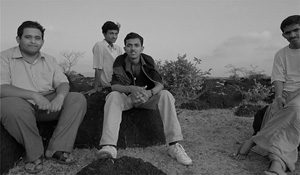
|
| Lakshmish (centre front) and friends |
Saturday 2nd March

Today’s outing is to Yana. I’ve wanted to come here ever since Lakshmish showed me a picture of it a few weeks ago - amazing limestone towers sticking up out of the forest, with an important Shiva temple at the bottom of one of them.
It’s very remote, reached by a local bus that goes for miles up a dirt road through the forest. It would be easy in a jeep, but I would never have imagined anybody would even consider driving a bus up here. The place when we arrive is just as amazing as it looked from the photos. I would love to stay here for a couple of days and see the rocks and the forest in the morning & evening light, not just in the mid-day haze. But there’s no guesthouse. I suggest that maybe I could just sleep in the forest and Lakshmish is appalled, says the forest is full of dangerous animals and snakes. So perhaps not.
There isn’t a bus back until six o’clock. I would be quite happy to stay here for a few hours but Lakshmish doesn’t want to wait so he blags us a lift in a minibus with a group of software engineers from Bangalore. They’re a cheerful, friendly bunch of guys. And although you might expect software engineers from Bangalore to be stereotypes of materialistic New India, blind to their country’s spiritual heritage, it actually isn’t so. One of them is seriously into meditation and a couple of the others go to yoga classes, so (thank god) we have something other than programming languages and microprocessor architectures to talk about on the walk back through the forest to their bus.
Sunday 3rd March
Visiting Lakshmish’s native place, Day Three
Day Three, and I don’t know if I can stand the pace much longer. The day starts with getting up at 4:30 for yoga practice (I thought/hoped I had left *that* behind me in Mysore), followed by a large breakfast prepared by Lakshmish’s mother - the first of many large meals - followed by a relentless twelve to fourteen hour schedule of being taken to see everything and meet everybody within about a thirty mile radius of the village, all linked together by a succession of mostly small and extremely crowded local buses. The day is generally rounded off by a nice sweaty hillwalk in the crushing heat to watch the sun set, after which Lakshmish somehow manages to be surprised that (a) it’s now dark and (b) we have to wait ages for a bus back to his village. Ah, the optimism of youth.
Another tough part of the schedule is all the eating. Lakshmish’s mother cooks delicious food, and so do his other female relatives. The difficult part is trying to politely and gratefully convey the idea that, although I *do* like the food, three large meals a day, plus substantial snacks, is simply more food than a yoga student is used to eating or can cope with. “Lakshmish, please explain to your mother/aunt/grandmother that the food is delicious - but please don’t make me eat any more!”
I only get limited sympathy from Lakshmish on this score. It seems some aspects of student life are the same the world over, because he starts telling me stories about eating contests at the Sanskrit college in Mysore. 15 to 20 chapatis, he says, is "easy", and 25 to 30 is "possible". That’s the endurance eating marathon. The sprint event is "how many idlis can you eat in one minute?". (An idli is a kind of steamed cake made from rice and fermented beans, about 2 or 3 inches across and an inch thick). The idlis have to be completely chewed & swallowed - stashing them away in your cheeks is cheating. Lakshmish’s personal best is 6 or 7; the college record is 9. (If you want to try this at home, folks, Lakshmish also says beginners are usually pretty ill after 2 or 3; and that drinking water is allowed but doesn’t actually help.)
 |
| “clean on the inside” |
Despite the crushing heat and humidity, Lakshmish absolutely forbids me from being seen in public without being properly dressed, which means long trousers and long-sleeved shirts at all times. This despite my one pair of long trousers being filthy, soaked with sweat and generally most unpleasant to wear. He explains this is all part of his campaign to re-educate people in his area about westerners. Apparently there’s a lot of prejudice against western visitors here, based on people believing that westerners at Gokarna - just a few miles up the coast - are dirty, scruffy, druggy hippies. He is trying to convince them that his yoga student friends from Mysore are different. I point out that I’m feeling pretty dirty and scruffy myself, after three days of sweating, bus journeys and hill walks in my one pair of trousers and two shirts - but he says people can still tell I’m “clean on the inside”. And his grandmother says I’m the first westerner she’s seen in her village for a year, so it seems as though the reputation of westerners in Gokarna is more based on hearsay than actual experience.
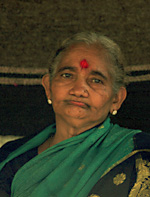 Lakshmish’s grandmother also says I sit like a Hindu. Yes! All those years of yoga classes, justified at last. It’s true that meeting & impressing women was one of my original motives for starting yoga classes years ago - but I can honestly say I never expected that to include grandmothers in North Karnataka villages.
Lakshmish’s grandmother also says I sit like a Hindu. Yes! All those years of yoga classes, justified at last. It’s true that meeting & impressing women was one of my original motives for starting yoga classes years ago - but I can honestly say I never expected that to include grandmothers in North Karnataka villages.
Monday 4th March to Wednesday 6th March.
Gokarna

I like Gokarna - it’s a really charming little Karnataka country town that hasn’t (yet) been ruined by tourism. The town itself is old and quaint and fascinating. The coastline is spectacular, harsher and more interesting to look at than the endless coconut groves of Kerala, and some of the beaches are idyllic.
Some of them aren’t, though. Om Beach - famous traveller/beach party hang out - looks lovely from a distance but close up it’s dirty and unpleasant. A large proportion of the westerners here are, in fact, pretty much as Lakshmish’s grandmother thinks - scruffy, heavy drug users who dress and behave with no respect for local mores in what is, after all, one of the holiest Hindu pilgrimage sites in India. I’m not at all impressed. The drug scene isn’t just cannabis in all its many varieties, either - lots of acid, and ketamine seems to be very much in fashion. Ugh. I don’t even have the impression that locals are getting much financial benefit from the western tourism - the people making money are beach cafe proprietors and (presumably) drug dealers, and most of them seem to be northerners or Nepalis.
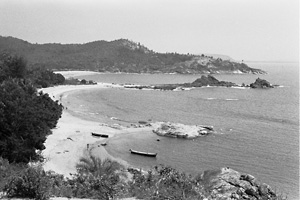
|
| Om Beach |
Still, comparing Gokarna to my extensive knowledge of other Indian beach resorts, it’s a far more interesting place than Kovalam.
Thursday 7th March
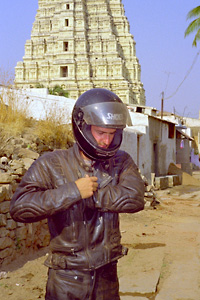 Eleven hours on the Gokarna-to-Hampi bus. Scenic for the first three or four hours, travelling up from the coast into the Western Ghats, and the bus is nicely un-crowded; but for the rest of the way the bus fills up, it gets hot, and Indian long distance bus purgatory kicks in with a vengeance. The Deccan is pretty unpromising-looking country: miles and miles of thin, dry farmland interspersed with big stretches of bare scrub. Difficult to see how it could have supported the vast empire that Hampi was capital of; much less feed the 50 million people who now live in Karnataka.
Eleven hours on the Gokarna-to-Hampi bus. Scenic for the first three or four hours, travelling up from the coast into the Western Ghats, and the bus is nicely un-crowded; but for the rest of the way the bus fills up, it gets hot, and Indian long distance bus purgatory kicks in with a vengeance. The Deccan is pretty unpromising-looking country: miles and miles of thin, dry farmland interspersed with big stretches of bare scrub. Difficult to see how it could have supported the vast empire that Hampi was capital of; much less feed the 50 million people who now live in Karnataka.
I finally reach Hampi, and outside my guesthouse I’m intrigued to see a BMW motorbike chained to a lamppost. Inside the guesthouse is Tony, an English guy who has done something I’ve wanted to do ever since I rented an Enfield and went touring in Kerala two years ago - he has ridden here overland from England, en route to Australia. He came via Iran and southern Pakistan in October during the war. Wasn’t that hideously dangerous, I ask him. He says no - the people there hate the American and English governments, naturally, but he didn’t experience any personal animosity directed at him at all.
Friday 8th March to Monday 11th March
Hampi
Hampi is fantastic. Miles and miles of amazing boulder-strewn granite hills dotted with literally hundreds of ruined temples, some of them very impressive indeed. I could think profound ozymandian thoughts about the remains of what was once, only five hundred years ago, India’s and possibly the world’s most impressive city reduced to a couple of scruffy little villages huddled in the ruins; or about how strange it is that people chose to put a city here, in this beautiful but harsh and weird landscape. Or about what kind of mentality would produce a civilization that leaves behind hundreds of superbly crafted carved granite temples, but whose dwellings were so flimsy that hardly a trace of them remains? But I won’t, I’ll just enjoy the landscape and the boulders and the ruins and think, “Hampi is fantastic”. The scene in the village and by the river is very much reminiscent of Kovalam - extremely touristified but pleasant and easy-going. But unlike Kovalam there are actually things to do apart from just hanging out in cafes - ruins to explore, limitless bouldering, loads of photo-ops.
There’s a definite end-of-season air about the place. It’s hot, the cafes are mostly empty and the sales pitches from the shopkeepers are half-hearted. I buy a shirt from a Kashmiri tailor then sit and play chess with him; he doesn’t speak a word of Kannada and has to speak English with the locals, just like I do. It’s getting too hot for him now, he says, and he’s ready to pack up and go home for the summer. But unlike in Gokarna, a lot of the other shopkeepers and traders I talk to are locals, Hampi or Hospet born & bred.
One minus point is the food. It isn’t as bad as it is in the Tibetan settlements near Mysore, and some of the cafes by the river have idyllic locations, but in three days all the meals I’ve had have been mediocre.
Saturday 9th March
Alan and the Temple of Doom
This morning I decide - inspired by an excellent photograph I’ve seen of a Hampi sunrise - that I’m going to walk up Matunga Hill at 5 o’clock and take pictures at dawn. But all the police and guidebook warnings I’ve heard about muggings in Hampi have made me worried, so I decide that walking through Hampi Bazaar before dawn carrying an obvious big bag of expensive cameras plus tripod, then heading off into the rocks in the dark followed by every dodgy character in the village, is probably a bad idea. The safer option I opt for instead is to walk up the main road as far as the Jain ashram, then go up the other side of the hill from there. Surely a Jain ashram must be about the safest place from violent crime it’s possible to be in the entire world? So I head up there, have a nice chat with the watchman, and for a bargain ten rupees persuade him to open the back gate that leads on the the hill. So far so good. The problem now, though, is that I’m on the opposite side of the hill from the path I know, stumbling about in the dark on a steep hillside covered with enormous granite boulders. But fairly soon I find a big stone staircase going up the hill, and follow it. And I think:

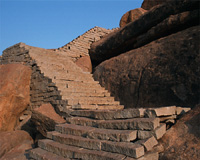
|

|
“Wow, here I am walking up a stone staircase by moonlight, to a Shiva temple on top of a hill, in the middle of an ancient ruined city in India. How cool is that? Pretty damned cool.”
…
“I wonder if mosquito repellent repels cobras”
“Don’t be silly - when was the last time you saw a cobra?”
“Er, last Saturday I think. Possibly Sunday. Definitely last weekend, anyway.”
“Shut up. Anyway, it’s dark. It’s probably too cold for cobras”
“If it’s so cold, why are you sweating walking up these steps?”
“Shut up.”
But I make it up the hill, unmolested by either muggers or cobras, and the views at sunrise are amazing as advertised. But having made my way up the hill in the dark with no problems, on the way back down in broad daylight I manage to get hopelessly lost in a banana plantation and end up having to wade out along a mosquito-infested irrigation ditch. Mosquito repellent may or may nor repel cobras, but it certainly doesn’t work 100% on mosquitos. Must remember to take my malarone.
Monday 11th March
Even in Hampi (especially in Hampi) sooner or later there comes a time when you think that if you look at one more old temple, you’ll probably throw up. At which point it’s time to head across the river for a spot of bouldering, then pack your bags and go and get the night train to Bangalore. Very much on my way home now.
Saturday 16th March
Home. That was one busy week travelling - night train from Hospet to Bangalore, drop the latest 20 rolls of film off in Bangalore on Tuesday to be processed - get solemn promises from the lab that yes, they will without fail be ready on Thursday. This is a lab I have used many times before and trust but still it’s a risk of something going wrong at the last minute, and makes me nervous. Afternoon train to Mysore. Say goodbye to everybody all over again, do last-minute gift shopping and re-pack everything. Back to Bangalore. Films are ready - great relief. Some good pictures too. Get on plane, leave India. It’s over.
Arrive at Munich airport, frazzled after not sleeping much on the overnight flight (I never do - I like looking down at the places I’m flying over too much. Amazing sunrise over Iran. The Crimea looks pretty interesting - anybody know any good yoga teachers there?) and one of those 30 minute run-from-international-to-domestic connections at Frankfurt that Lufthansa love to schedule, just when a couple of hours to wind down and decompress a bit would be good. But still, it gets me - and all my luggage, which is always a pleasant surprise even though I’ve only actually lost it once - home.
Arriving at airports with nobody to meet me is consistently one of the worst moments of being single and travelling a lot. But it’s partly my fault for arriving on a workday, I’m sure some of my friends would have turned out to pick me up otherwise. Coming out of the terminal and not being mobbed by touts is *such* a relief. I get in a taxi. Wow, this car, it’s so big. So quiet. So smooth. Why aren’t there any holes in the road? Where are all the cows? I get home - don’t remember the flat being this clean when I left - either my friends have been scrubbing floors as well as watering the plants and checking the post (unlikely) or (more likely) India has changed my perception of clean-ness. Go to my local organic shop to get some food and how ironic, they have mangoes. The guy at the fruit shop in Mysore has been promising mangoes "tomorrow" for weeks but I haven’t seen a single one in India. (These ones come from South Africa). Go to bed at two in the afternoon "for a nap" and wake up at six o’clock on Saturday morning.
Which feels like a good time for yoga practice, so I do. Lovely. Not too horribly stiff despite the cold, and for some bizarre reason my finishing sequence is really good - very strong & balanced inversions, whereas my shoulderstand & headstand felt weak & wobbly a lot of the time in Mysore. It’s odd but good that *something* always seems to suddenly go better when I arrive in a new place. I feel great. Now it’s time for a coconut. But wait, there aren’t any. Aargh! Where is this place?
Tuesday 19th March
Reflections on Life Back Home In Europe. I’m European. Visiting India is great, but this is where I belong. I actually like the cooler climate. I like looking at the trees starting to bud and the crocuses in the parks. I see pictures of all the snow in the mountains and think “that must have been nice”. Everything is so expensive though. I went to my local coffee shop for a capuccino and a piece of cake - 250 rupees! Jeez. I went to a camera shop to get folders and sleeves so that I can file all my pictures from India, and notice that they have the Ansel Adams Centenary book “reduced” from 180 Euros to 150 (an Euro is a little less than a US dollar). Don’t look, just buy the folders and get out. (On the whole, I think I’m reasonably free from the burden of attachment to material things these days - except when it comes to photography toys & books). Better start earning some money again - fortunately, I probably have a contract starting after Easter.
Went to my first class back with my regular teacher today. (Had booked for one on Sunday, but it was the first sunny Sunday afternoon of the year here so no other students showed up. We went to a beer garden instead - hey, somebody once told me Guruji says jetlag is a legitimate reason to “take rest” - and I did practice Saturday.) Today’s practice was great, my best ever - it felt as if everything I struggled to learn in Mysore suddenly clicked into place now that I’m back among old friends and familiar surroundings. Am not so naïve as to think every practice will be like this from now on - but it was a marvellous experience nevertheless.
I decided a while ago that my first class back home would be the stopping point for this diary (“because what happens to anybody who gets into any kind of forced/regular writing is that he’s bound to make a useless fool of himself now & then” - Hunter S. Thompson). So that’s it for the text. Over the next few weeks I’ll be going through the massive task of editing and scanning the worthwhile pictures from the 83 rolls of film I shot in India, in the course of which the diary will become illustrated and I will greatly enlarge my India photo gallery.
THE END
| all text and images © 2002 Alan Little | < February |